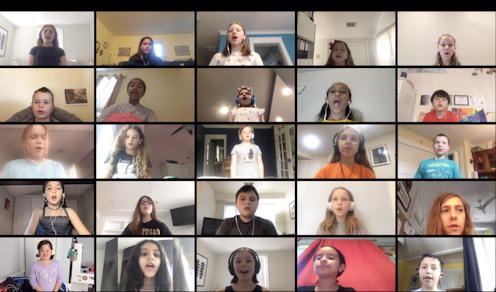Young musicians can perform on virtual stages when schools are closed
Much like what everyone in showbiz from Lady Gaga to Lang Lang seems to be doing, school-age music students are using apps and software to play instruments and sing together.

Live performances ceased across the U.S. and around the world in early 2020 as governments everywhere barred large gatherings to slow the spread of the coronavirus.
New York City’s Times Square resembled a ghost town by mid-March. The Metropolitan Opera of Los Angeles went dark. Nashville converted its Music City Center into a regional hospital for COVID-19 patients.
But the music didn’t stop.
Everyone from The Roots, the hip-hop ensemble that serves as talk show host Jimmy Fallon’s house band, to the eclectic jazz YouTuber Carlos Eiene filled the void through their innovative use of online media. A wide array of prominent musicians, including Celine Dion, Andrea Bocelli, Lady Gaga, Lang Lang and John Legend, gazed into cameras often set up in their own homes to deliver entertainment straight to their fans.
Likewise, student bands, orchestras and choirs from coast to coast could no longer learn and rehearse together in person once nearly all schools closed their doors to slow the spread of the coronavirus. As a music education scholar who researches online music-making, I’ve found it exciting to see so many professionals and students alike use online media to keep making music together and to share their music with others.
Virtual concerts
When music teachers moved instruction online, they tried to get students to sing and play music together through teleconferencing software as an alternative to their end-of-year performances. However, they quickly realized that delays in the audio made it impossible to make music sound the same as it did in the rehearsal room.
The alternative to teleconferencing software is producing virtual ensemble performances, which are compilations of prerecorded sound and sometimes even video that are put together with sound and video editing software. During the pandemic, I saw teachers from across the world sharing their students’ works similar to a collaboration between students from Purdue University and the University of Connecticut I led three years earlier. My students at Purdue were ecstatic to see their ukulele-playing tests turned into a music video featuring their virtual friends hundreds of miles away.
The all-virtual spring 2020 school concert season reinforced exciting ways of sharing how schools bring students together to create music online. By recording and mixing music that can then be streamed online as a virtual performance, students’ works can be presented without the problems that arise when many people try to make music together in real time with teleconferencing apps.
Singing, dancing and playing instruments
Show choir students from Oak Park and River Forest High School in Illinois were in the middle of their competition season when the pandemic hit. So their teachers pieced together videos of them singing and dancing.
Individual band members from Mt. Carmel High School in San Diego put on their formalwear and recorded themselves playing Pomp and Circumstance to honor graduating seniors.
And community-based youth ensembles like the Chicago Children’s Choir, the Showcase Music School’s Youth Orchestra in San Jose, California and Little Kids Rock, a nonprofit that supports music programs nationwide, didn’t let COVID-19 stop them from making music together.
Sound editing programs like Soundtrap by Spotify and Pro Tools, video software like Flipgrid and Adobe Premiere, and compilation apps like Acapella by PicPlayPost and BandLab made these productions from shuttered schools possible.
Many music teachers quickly realized that putting together a virtual ensemble was complicated because it requires technological skills that are not always taught in music education university programs.
Fortunately, some tech-savvy educators offered advice about putting these performances together, and sound engineers shared their expertise to help create virtual performances.
Meanwhile, many students realized they could make music with others, regardless of geographic constraints. Examples I’ve seen include singing pen pals who send karaoke videos across the globe on the Sing! app and online master classes that bring the expertise of professional musicians to students like those attending the Herbie Hancock Institute of Jazz. These relationships can continue and flourish as schools resume in person.
What’s next?
Questions abound regarding what music instruction will be like once K-12 schools open their doors again.
Many school districts planning a mix of online and in-person instruction haven’t shared details about whether and when music classes and rehearsals might be phased back in.
Those plans are complicated by evidence that singing and playing wind instruments, such as trumpets and flutes, can increase the risk of spreading COVID-19. In addition, if students spend less time in school, core academic classes may dominate their schedules more than ever.
Based on what happened between March and June 2020, one thing is certain: Music education and performance can continue if students can’t meet or rehearse face to face as long as educators are willing and able to use the online tools at their disposal.
After all, the internet lets people of all ages continue making music together and share that music with online audiences.
Christopher Cayari receives funding as a consultant and speaker on topics related to music learning and online media creation. He also works for Purdue University and studies the topics discussed in this article.
Read These Next
As DOJ begins to release Epstein files, his many victims deserve more attention than the powerful me
Powerful men connected to Jeffrey Epstein are named, dissected and speculated about. The survivors,…
How to reduce gift-giving stress with your kids – a child psychologist’s tips for making magic and a
Depending on family circumstances and a child’s personality type, gift giving runs the gamut of fun…
The world risks forgetting one of humanity’s greatest triumphs as polio nears global eradication − 7
Polio may finally be defeated in the next 5 years. Will the world recognize what an extraordinary achievement…






